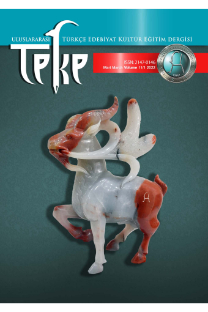EURİPİDES’İN MEDEA’SI, WILLIAM SHAKESPEARE’İN MACBETH’İ VE ÖZEN YULA’NIN GAYRİ RESMİ ROXELANA’SINDAKİ BASKIN KADIN FİGÜRLERİNİN TEMATOLOJİK BİR KARŞILAŞTIRMASI
Bu makale, Euripides’in Medea’sı, William Shakespeare’in Macbeth’i ve Özen Yula’nın Gayri Resmi Roxelana’sındaki güçlü kadın karakterlerin tasviriyle tematolojik bir karşılaştırma sunmaktadır. Üç oyunun feminist analizi, kadınların her zaman güç, kontrol ve tanınma arayışında olarak tasvir edildiğini göstermektedir. İktidara olan arzuları ataerkillik tarafından çeşitli denemeler ve sıkıntılarla sınanır. Üç kadın karakter farklı kültürlere ve zamanlara ait olsalar da ataerkil baskı, güç ve tanınmaya yönelik çaresiz arzular gibi ortak temaları paylaşıyorlar. Üç kadının ataerkil çerçeveye göre alışılmadık erkeksi davranışlar sergileyerek beklenen cinsiyet rollerinden saptıkları gözlemlenmektedir. Feminist eleştiri, onların kültürel olarak inşa edilmiş toplumsal cinsiyet rollerinden sapmalarının ardındaki motivasyonları açığa çıkarmaktadır. Karşılaştırmalı edebiyatın bir alt alanı olan tematolojik analizde, feminist eleştirinin yardımıyla seçilen metinler, kendilerine özgü temaları ile birbirleriyle ilişkileri açısından karşılaştırılmıştır.
Anahtar Kelimeler:
Tematoloji, feminizm, baskın kadınlar, ataerkillik
A THEMATOLOGICAL COMPARISON OF THE DOMINANT FEMALE FIGURES IN EURIPIDES’ MEDEA, WILLIAM SHAKESPEARE’S MACBETH AND ÖZEN YULA’S UNOFFICIAL ROXELANA
This paper presents a thematological comparison to the portrayal of powerful woman characters in Euripides’s Medea, William Shakespeare’s Macbeth, and Özen Yula’s Unofficial Roxelana. The feminist analysis of the three plays indicates that women are portrayed as always seeking power, control, and recognition. Their desire for power is tested by patriarchy on several trials and tribulations. Even though the three female characters belong to different cultures and times, they share common themes of patriarchal oppression, desperate desires for power and recognition. The three women are observed to deviate from expected gender roles by exhibiting unconventional manlike behaviours according to the patriarchal framework. The feminist criticism reveals the motivations behind their deviation from their culturally constructed gender roles. Through the thematological analysis, as a subfield of comparative literature, the selected texts are compared in their relation to each other in terms of their unique themes by the help of feminist criticism.
Keywords:
Thematology, feminism, dominant females, patriarchy,
___
- Barzilai-Lumbroso, R. (2009). Turkish men and the history of Ottoman women: Studying the history of the Ottoman dynasty’s private sphere through women’s writings. Journal of Middle East Women’s Studies 5(2), 53-82. Bernstein, J. A. (2002). Bewitched, bothered and bewildered: Lady Macbeth, sleepwalking, and the demonic in Verdi’s Scottish opera. Cambridge Opera Journal, 14(1/2), 31-46.
- Biderci Dinç, D. (2019). Reading William Shakespeare’s Macbeth as a political text. International Social Sciences Studies Journal 5(30), 903-914.
- Chamberlain, S. (2005). Fantasizing infanticide: Lady Macbeth and the murdering mother in early modern England. College Literature 32(3), 72-91.
- Cixous, H. (1976). The laugh of the Medusa. (K. Cohen & P. Cohen, Trans.). The University of Chicago Press 1(4), 875-893.
- Cixous, H. (1981). Castration or decapitation? (A. Kuhn, Trans.) Signs 7(1), 41-55.
- Euripides. (1963) Medea and other plays. (P. Vellacott, Trans.). Penguin Books. (Original work published 431 B.C.E.)
- Fallaize, E. (2007). Simone de Beauvoir and the demystification of woman. In G. Plain & S. Sellers (Eds.), A history of feminist literary criticism (pp. 85-100). Cambridge University Press.
- French, M. (1992) “Macbeth” and masculinity. In A. Sinfield (Ed.), Macbeth: New casebooks (pp. 16-32). Palgrave Macmillan.
- Isom-Verhaaren, C. (2006). Royal French women in the Ottoman sultans’ harem: The political uses of fabricated accounts from the sixteenth to the twenty-first century. Journal of World History 17(2), 159-196.
- Hall, E. (1999). Medea and British legislation before the First World War.
- Greece & Rome 46(1), 42-77. Levin, J. (2002). Lady MacBeth and the daemonologie of hysteria. ELH 69(1), 21-55.
- Rickert, G. (1987). Akrasia and Euripides’ Medea. Harvard Studies in Classical Philology 91, 91-117.
- Shakespeare, W. (2003). Macbeth by William Shakespeare. B. A. Mowat, & P. Werstine (Eds.). Washington Square Press. (Original work published 1623)
- Showalter, E. (1985). The female malady: Women, madness, and English culture. Pantheon Books New York.
- Stevens, C. (1999). Hélène Cixous and the need of portraying: on portrait du soleil. In R. Barreca, & L. A. Jacobus (Eds.), Hélène Cixous: Critical Impressions (pp. 201-225). Gordon & Breach Publishing Group.
- Uluçay, M. Ç. (1953) Letters from the harem: The letters of Hurrem Sultan. Yeni Tarih Dünyası 2(19-20), 768-769.
- Yula, O. (2017). Unofficial Roxelana: And other plays. University of Chicago Press.
- Woolf, V. (1943) Three guineas. The Hogarth Press.
- ISSN: 2147-0146
- Yayın Aralığı: Yılda 4 Sayı
- Başlangıç: 2012
- Yayıncı: Cengiz Alyılmaz
Sayıdaki Diğer Makaleler
YABANCI DİL OLARAK TÜRKÇE VE İNGİLİZCE ÖĞRETİMİNDE AKTARIMLARLA İLGİLİ ÇALIŞMALARIN ANALİZİ
YENİŞEHİRLİ AVNÎ’NİN “DUYMASUN” REDİFLİ GAZELİNE PSİKANALİTİK EDEBİYAT KURAMI ÇERÇEVESİNDE BAKIŞ
TÜRKÇE DERS KİTAPLARININ ANAHTAR YETKİNLİKLER AÇISINDAN İNCELENMESİ (8. SINIF ÖRNEĞİ)
ÖZEL YETENEKLİ VE TİPİK GELİŞİM GÖSTEREN ÖĞRENCİLERİN ÇALIŞMA BELLEĞİ BECERİLERİNİN İNCELENMESİ
"ADIL / AD (+İYELİK) +{lI4K}” YAPISINDA +{lI4K} BİÇİMBİRİMİNİN “+(A) göre” İŞLEVİ ÜZERİNE
SINIF ÖĞRETMENLERİNİN AKADEMİK İYİMSERLİKLERİ VE MESLEKİ ÖZ YETERLİK ALGILARI ARASINDAKİ İLİŞKİ
Merve KURUM, Murat İNCE, Cevat EKER
YUSUF HAS HACİB VE EDİP AHMET YÜKNEKİ’NİN AHLAK ANLAYIŞLARINDA RASYONALİST TEMELLER
